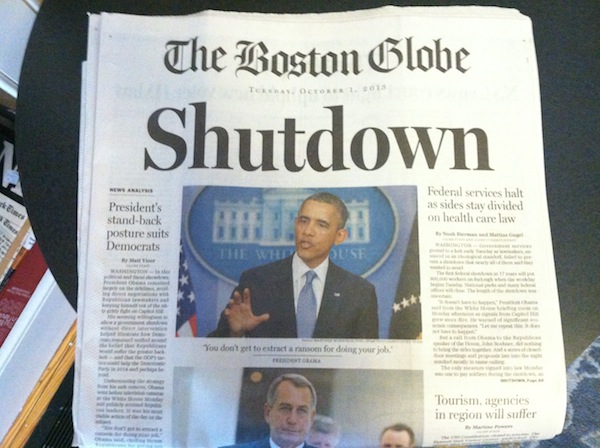The shutdown of the federal government will be unfortunate for a lot of people, but for journalists, it’s also a chance to get people’s attention. For example, check out The Boston Globe’s print strategy for today:

Over at Quartz, Zach Seward had a different idea involving a blaring headline. In February 2011, he registered the site IsTheGovernmentShutDown.com in advance of a possible, but ultimately avoided, federal closure. He writes in an email:
As the current shutdown loomed, I remembered this weekend that I still owned the domain. We relaunched the site on Sunday and tweeted it a bit, but we knew that if it was going to catch fire, it would be on Monday night. And that’s what happened.
What was different about the rebooted site and the 2011 version is that, in between, Atlantic Media founded Quartz and hired Seward as a senior editor. (He previously worked here at Nieman Lab.) Knowing the site would go viral just before midnight on Monday night, Seward decided that in addition to changing the big NO to a YES, he would also link to two context–building stories by Quartz writers.
“We wanted to keep it simple, in the tradition of single-serving sites,” writes Seward. As of this morning, about 85,000 people had visited the site — but what Seward found even more interesting was how many of those readers clicked the Quartz headlines.
One thing I was curious to see was how many people would click on one of the links to Quartz articles. We weren’t expected it to be a huge traffic driver or anything, but it looks like 19% of visits to isthegovernmentshutdown.com ended with a click to qz.com, which is a pretty good clickthrough rate. As an experiment, I think it showed that if you can get people to the right place for a certain event (that’s the hardest part), you can funnel some portion of them to anything else that’s related.
This isn’t the first time Quartz has experimented with registering topical, humorous domain names as traffic drivers. Seward said he finds something about them “irresistible at the right moment.” And, of course, there have been plenty of others with similar ideas, like The Guardian’s pope-watching IsThereWhiteSmoke.com
For a slightly less news-oriented take on the same issue, check out the site’s Bizarro, IsTheGovernmentOpen.com by Michael Tomko. And to learn a bit more about the phenomenon — even though it’s a bit outdated, being from 2008 — head to IsThisYourPaperOnSingleServingSites.com.
2 comments:
Thanks for the mention! Much appreciated.
Nice article and a very useful site! Take one of our polls at TheGovernmentShutdown.com!
Trackbacks:
Leave a comment